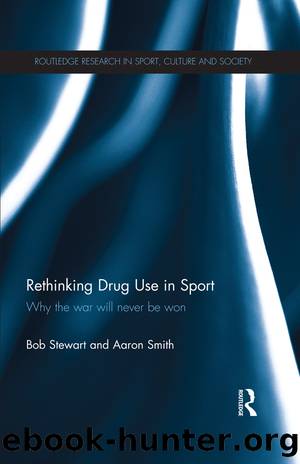Rethinking Drug Use in Sport by Bob Stewart Aaron Smith

Author:Bob Stewart, Aaron Smith [Bob Stewart, Aaron Smith]
Language: eng
Format: epub
Tags: Sports & Recreation, General, Cultural & Social Aspects, Business Aspects
ISBN: 9781135118471
Google: YjkSBgAAQBAJ
Barnesnoble:
Publisher: Routledge
Published: 2014-01-10T01:00:34+00:00
Figure 9.1 Life-course transitions, turning points, and critical incidents
Life-course conceptual models
A number of life-course models have been applied to the analysis of individual development through the lifespan, examining the ways in which previous work, family, and leisure experiences interdependently shape peopleâs futures. Life-course models shed light on how life events impact upon health and leisure behaviours by drawing on biomedical analyses of health and welfare. They include 1) the latent effects model, 2) the pathway model, 3) the social mobility model, and 4) the cumulative life-course model. We briefly describe each below.
The latent effects life-course model hypothesises that adverse early life experiences increase health risks in later life, independent of any intervening social, economic, lifestyle, or traditional risk factors. Certain early life events may have strong independent effects on adult health by working through âbiological chains of riskâ. For example, prenatal and early life socio-economic factors will affect biological resources, which will in turn influence adult health. More generally, the operation of biological or developmental influences during early âsensitive periodsâ will permanently impact on developing individuals in either positive or negative ways.
In the pathway model, early life events and environments will influence later life experiences, opportunities, and health risk factors. It assumes a developmental process that links early life psychosocial environments with adult health risks via pathway effects. Here, early experiences place an individual on a certain life trajectory, eventually impacting adult health. The term âsocial chains of riskâ is used to explain how early events influence later life health status. As a result, âongoing social processesâ and âa continuity of social circumstancesâ lead to either advantageous or disadvantageous chains of advantage.
Social mobility theories assume that an individualâs social and economic circumstances relentlessly shape their behaviour across the life course, impacting upon their adult health. This model posits a mixed range of possibilities whereby deprivation in early life can be followed by 1) material affluence to produce hybrid health outcomes, 2) natural âhealth selectionâ, where less healthy individuals tend to have downward social mobility and healthier individuals tend to be upwardly mobile, and 3) a âhealth constraintâ factor, where socially mobile individuals possess health characteristics of the class they join as well as the âclassâ they depart.
Cumulative life-course models assume that psychosocial and physiological experiences, combined with environmental factors, work to influence adult disease risk during both early and later life. Different combinations will produce a wide variety of health outcomes. This model highlights the ways in which individuals build up their stocks of biological resources, and how, over the life course their âhealth and physical capitalâ can vary, with important implications for their health status.
Download
This site does not store any files on its server. We only index and link to content provided by other sites. Please contact the content providers to delete copyright contents if any and email us, we'll remove relevant links or contents immediately.
Harry Potter and the Goblet Of Fire by J.K. Rowling(3046)
Never by Ken Follett(2882)
Shadow of Night by Deborah Harkness(2718)
Ogilvy on Advertising by David Ogilvy(2682)
Zero to IPO: Over $1 Trillion of Actionable Advice from the World's Most Successful Entrepreneurs by Frederic Kerrest(2396)
The Man Who Died Twice by Richard Osman(2300)
Machine Learning at Scale with H2O by Gregory Keys | David Whiting(2292)
Book of Life by Deborah Harkness(2263)
How Proust Can Change Your Life by Alain De Botton(2261)
My Brilliant Friend by Elena Ferrante(2224)
0041152001443424520 .pdf by Unknown(2220)
The Tipping Point by Malcolm Gladwell(2205)
How to Pay Zero Taxes, 2018 by Jeff A. Schnepper(2100)
Will by Will Smith(2043)
Purple Hibiscus by Chimamanda Ngozi Adichie(1982)
Hooked: A Dark, Contemporary Romance (Never After Series) by Emily McIntire(1960)
Borders by unknow(1786)
Rationality by Steven Pinker(1765)
Daughter of Smoke and Bone by Laini Taylor(1744)
